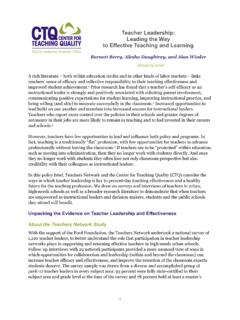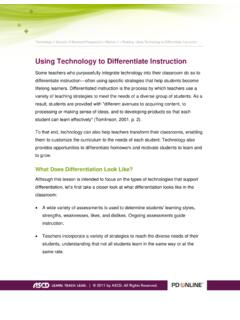Transcription of Teaching and Learning in Nursing
1 Nurse educators' use of lecture and active learningTim Bristol, PhD, RN, CNE, ANEF, FAADN, FAANa, Debra Hagler, PhD, RN, ACNS-BC, CNE, CHSE, ANEF, FAANb,Jacquelyn McMillian-Bohler, PhD, CNM, CNEc, Rita Wermers, MSN, ANP-BCd,Daniel Hatch, PhDe, Marilyn H. Oermann, PhD, RN, ANEF, FAANc, aWalden University, Minneapolis, MN, USAbCollege of Nursing & Health Innovation, Arizona State University, Phoenix, AZ, USAcDuke University School of Nursing , Durham, NC, USAdArizona State University, Phoenix, AZ, USAeDuke University School of Nursing , Durham, NC 27710, USAabstractarticle infoArticle history:Accepted 10 December 2018 Keywords:Active learningLectureNursing courseTeaching strategiesThe results of numerous studies suggest that by using active Learning strategies educators can improve studentlearning outcomes. We asked 536 nurse educators Teaching in prelicensure programs to estimate the extentthat they integrate active Learning strategies into their courses.
2 There were no relationships identified betweenthe estimated extent of active Learning use and program National Council Licensure Examination pass rates. 2019 Organization for Associate Degree Nursing . Published by Elsevier Inc. All rights have long defaulted to lecturing as a strategy for effi-ciently presenting course content. However, the teacher, in choosingto lecture, is assigning students to the relatively passive role of listen-ing. It is not surprising that many students are unable to apply infor-mation from lecture in a meaningful way (Waldeck & Weimer, 2017).There isa growingbody of researchhighlightinghow active learn-ing strategies can promote deeper levels of information processingthan those achieved through listening to lectures. Despite the in-creased discussion of and evidence for active Learning , it is not clearhow frequently nurse educators choose to use lectures or activelearning strategies in their classes.
3 The purpose of this article is to re-port results of a survey regardingtheextenttowhich nurse educatorsreport they use lecture and active Learning in their prelicensurenursing and Eison (1991)popularized the concept of active as Learning activities that engage students, active learningencourages students to think deeply about what they are doing(Hyun, Ediger, & Lee, 2017). Active Learning is based on constructivisttheory, which emphasizes that, in order to learn, students need to beengaged with the content. With active Learning , students are the pri-mary knowledge creators and focus (Cattaneo, 2017). In comparison,the traditional passive Learning approach emphasizes the instructor,who, as the expert, lectures to students while they sit passively re-ceiving the Learning promotes higher-order critical thinking skillsand involves Teaching strategies such as case studies, class debates,think pair share activities, role playing, peer Teaching , gaming, the1-minute paper, or questions embedded into a lecture (Adkins,2018).
4 When students feel included and capable, they are morewilling to work through challenging material. Active Learning alsoincreases a sense of community among learners and instructors(Umbach & Wawrzynski, 2005). Students who perceive a member-ship in the classroom community feel valued and supported. Theyare more likely to take ownership of their Learning and considernew perspectives, a necessary step for Learning to occur. Active learn-ing strategies provide this connection for students and also enableinstructors to assess students' understanding of the course contentin real time. A systematic review of active Learning in Nursing andhealth profession courses byWaltz, Jenkins, and Han (2014)showedpositive outcomes in 15 of 22 studies. Although many of the studiesTeaching and Learning in Nursing 14 (2019) 94 96 This research did not receive anyspecific grantfrom fundingagenciesinthepublic,commercial, or not-for-profit sectors.
5 Corresponding (T. (J. (R. (D. ( Oermann). 2019 Organization for Associate Degree Nursing . Published by Elsevier Inc. All rights lists available atScienceDirectTeaching and Learning in Nursingjournal the review represented low-level evidence, they provide a founda-tion for further Learning increases students' retention of information,improves performance on course assessments, and increasesstandardized test scores (Styers, Van Zandt, & Hayden, 2018;Ulrich et al., 2017). Results from a study byMatsuda, Azaiza,and Salani (2017)support the concept that when students areconnected with course content, Learning outcomes improve over-all. Active Learning also improves students' perceptions of inclu-siveness in the classroom and their self-efficacy (Lumpkin,Achen, & Dodd, 2015). A meta-analysis of science, technology, en-gineering, and mathematics (STEM) courses demonstrated thatstudents in lecture courses were times more likely to failwhen compared with those in active Learning courses.))))
6 In addi-tion, average examination scores of the active Learning courseparticipants were 6% higher than lecture course participants(Freeman et al., 2014).Active Learning strategies may improve some student learningoutcomes, but does using active Learning strategies support newgraduate success on the Nursing licensure examination? Mostliterature regarding forecasting graduate success on the NationalCouncil Licensure Examination (NCLEX) is tied to traditionalmarkers including predictor examinations and course grades(Hinderer, Dibartolo, & Walsh,2014; Johnson, Sanderson, Wang,& Parker, 2017). As a starting point, we conducted a survey toexplore how educators perceive the extent of their use of lectureversus active Learning in the classroom in prelicensure nursingprograms. Although there is a large body of literature on activelearning strategies in Nursing , the extent to which faculty acrossschools of Nursing perceive they use lecture versus active learningin the classroom is not study used a survey to collect data on the extent of time nurs-ing faculty lectured to their students in the classroom or engaged inactive Learning .
7 The survey initially asked respondents if theytaught in a prelicensure registered nurse or practical/vocationalnursing program. Only those faculty who indicated they taughtcourses at the prelicensure level received the rest of the survey included three items. One item asked faculty to iden-tify the percent of classroom time that they lecture to students,with responses ranging from none to more than 75% of the time. Asecond item asked faculty how students would describe their classesin terms of lecture versus active Learning : possible responses rangedfrom only active Learning strategies (no lecture) in class to all lecture(and no active Learning ). Onefinal item asked respondents to indi-cate if their school's NCLEX pass rate in 2017 exceeded the nationalaverage. The survey items were reviewed by experts for clarity. Nodemographic data or information about the Nursing program e-mail was sent to the NurseTim, Inc.
8 List serve in August2018, with a link to the electronic survey. The survey remainedopen for 1 month, and there was no attempt to send respondent could only answer the survey one time. The studywas approved by the authors' university institutional were downloaded from the survey software to Excel(Microsoft) and then to SAS Version for analysis (SAS InstituteInc. Cary, NC). Data were analyzed with frequency statistics and bi-variate chi-square analysis to determine if there were differences inNCLEX pass rates based on the extent of lecture and active learningin were 536 respondents to the survey. Of these, 438 taught inprelicensure Nursing programs and answered the three survey a few faculty (n= 22, ) do not lecture in their courses oruse it less than 25% of the time (n= 66, ). Slightly more(n= 84, ) use predominantly lecture (over 75% of classroomtime). Most faculty lecture to students anywhere from 26% to 75%of the time (n= 266, ).
9 Nearly half of the respondents (n= 213, ) stated that theirstudents would describe their classes as including equal parts lectureand active learningor mostly lecture (n= 185, ). Few studentswould describe classes in which only active Learning strategies wereused (n= 24, ).Pass rates in the majority of the respondents' programs, as re-ported by the respondents, were above the benchmark (n= 340, ). Chi-square tests indicated there were no differences infirst-time NCLEX pass rates based on the percent of lecture used inthe classroom, 2(3,N= 438) = ,p= .93, or the balance be-tween lecture and active Learning in class, 2(3,N= 438) = ,p=. Learning strategies engage students in the Learning processand encourage them to reflect on their Learning . Although nursingstudents in many programs prefer to be passive learners, Nursing fac-ulty are integrating active Learning in their courses (Oermann, 2015).
10 Often, active Learning is implemented through collaborative groupwork, with students working together to analyze cases related tothe concepts being learned in the class. A meta-analysis byFreemanet al. (2014)of 225 studies comparing traditional lecture to activelearning in STEM disciplines demonstrated improved examinationscores with active Learning methods should be selected based on the Learning out-comes to be achieved and what methods would work best consider-ing those outcomes. Although many faculty have embraced activelearning, lecture is still an effective method for presenting informa-tion to students, particularly when the teacher integrates contentfrom multiple sources that students may not have access to or timeto read. Lecture allows the teacher to present up-to-date evidence,which may not be available in textbooks, explain complex concepts,and clarify confusing points for students.








